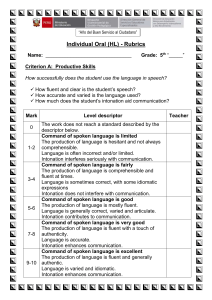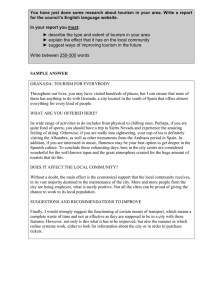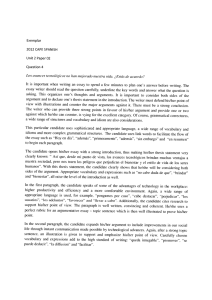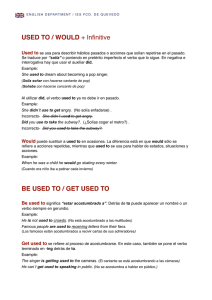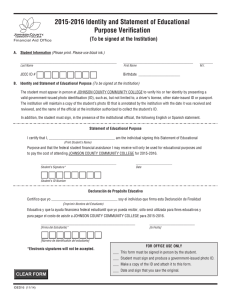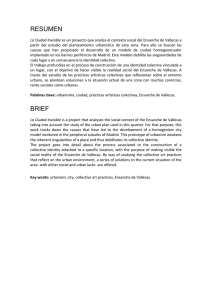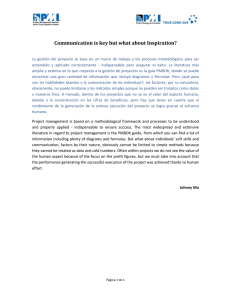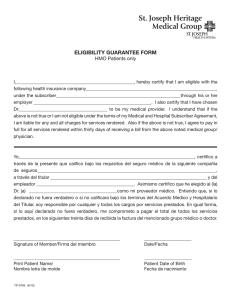Powerpoint Appearance and Content Rubric: Artista del Milenio
Anuncio
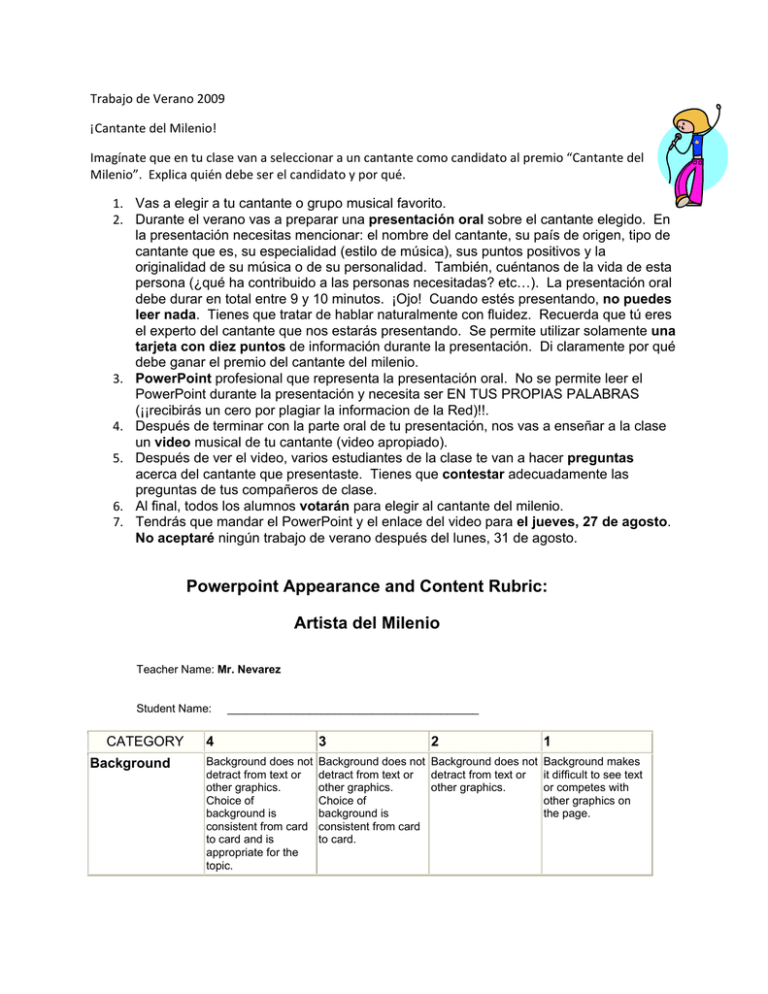
Trabajo de Verano 2009 ¡Cantante del Milenio! Imagínate que en tu clase van a seleccionar a un cantante como candidato al premio “Cantante del Milenio”. Explica quién debe ser el candidato y por qué. 1. Vas a elegir a tu cantante o grupo musical favorito. 2. Durante el verano vas a preparar una presentación oral sobre el cantante elegido. En la presentación necesitas mencionar: el nombre del cantante, su país de origen, tipo de cantante que es, su especialidad (estilo de música), sus puntos positivos y la originalidad de su música o de su personalidad. También, cuéntanos de la vida de esta persona (¿qué ha contribuido a las personas necesitadas? etc…). La presentación oral debe durar en total entre 9 y 10 minutos. ¡Ojo! Cuando estés presentando, no puedes leer nada. Tienes que tratar de hablar naturalmente con fluidez. Recuerda que tú eres el experto del cantante que nos estarás presentando. Se permite utilizar solamente una tarjeta con diez puntos de información durante la presentación. Di claramente por qué debe ganar el premio del cantante del milenio. 3. PowerPoint profesional que representa la presentación oral. No se permite leer el PowerPoint durante la presentación y necesita ser EN TUS PROPIAS PALABRAS (¡¡recibirás un cero por plagiar la informacion de la Red)!!. 4. Después de terminar con la parte oral de tu presentación, nos vas a enseñar a la clase un video musical de tu cantante (video apropiado). 5. Después de ver el video, varios estudiantes de la clase te van a hacer preguntas acerca del cantante que presentaste. Tienes que contestar adecuadamente las preguntas de tus compañeros de clase. 6. Al final, todos los alumnos votarán para elegir al cantante del milenio. 7. Tendrás que mandar el PowerPoint y el enlace del video para el jueves, 27 de agosto. No aceptaré ningún trabajo de verano después del lunes, 31 de agosto. Powerpoint Appearance and Content Rubric: Artista del Milenio Teacher Name: Mr. Nevarez Student Name: CATEGORY Background ________________________________________ 4 3 2 Background does not detract from text or other graphics. Choice of background is consistent from card to card and is appropriate for the topic. Background does not Background does not detract from text or detract from text or other graphics. other graphics. Choice of background is consistent from card to card. 1 Background makes it difficult to see text or competes with other graphics on the page. Originality Presentation shows considerable originality and inventiveness. The content and ideas are presented in a unique and interesting way. Presentation shows some originality and inventiveness. The content and ideas are presented in an interesting way. Presentation shows an attempt at originality and inventiveness on 1-2 cards. Presentation is a rehash of other people's ideas and/or graphics and shows very little attempt at original thought. Text - Font Choice & Formatting Font formats (e.g., color, bold, italic) have been carefully planned to enhance readability and content. Font formats have been carefully planned to enhance readability. Font formating has been carefully planned to complement the content. It may be a little hard to read. Font formatting makes it very difficult to read the material. Spelling and Grammar Presentation has no misspellings or grammatical errors. Presentation has 1-2 Presentation has 1-2 Presentation has misspellings, but no grammatical errors more than 2 grammatical errors. but no misspellings. grammatical and/or spelling errors. Sequencing of Information Information is organized in a clear, logical way. It is easy to anticipate the type of material that might be on the next card. Most information is organized in a clear, logical way. One card or item of information seems out of place. Some information is logically sequenced. An occassional card or item of information seems out of place. There is no clear plan for the organization of information. A few graphics are not attractive but all support the theme/content of the presentation. All graphics are attractive but a few do not seem to support the theme/content of the presentation. Several graphics are unattractive AND detract from the content of the presentation. Project includes most material needed to gain a comfortable understanding of the material but is lacking one or two key elements. It is an adequate study guide. Project is missing more than two key elements. It would make an incomplete study guide. Project is lacking several key elements and has inaccuracies that make it a poor study guide. Use of Graphics All graphics are attractive (size and colors) and support the theme/content of the presentation. Effectiveness Project includes all material needed to gain a comfortable understanding of the topic. It is a highly effective study guide. SPANISH STANDARD LEVEL Evaluation Criteria Oral Component Criterion A: Language To what extent does the candidate speak the language fluently and accurately? • How fluent is the language spoken by the candidate? (Fluency refers to ease of speaking.) • • How correct and idiomatic are the grammar and vocabulary used by the candidate? To what extent does intonation contribute to communication? (Intonation refers to the sounds and rhythms of the language that are essential for effective communication. It does not refer to accent. The candidate is not expected to sound like a native speaker of the language.) Achievement Level 0 Level 1 is not achieved. 1‐2 Command of the spoken language is very limited. • The production of language is very hesitant and /or incomprehensible • The use of grammar and vocabulary is generally incorrect and / or very limited • Inaccurate intonation consistently interferes with communication 3‐4 Command of the spoken language is limited • • • The production of language is generally hesitant and not always comprehensible The use of grammar and vocabulary is often incorrect and/ or limited Inaccurate intonation rarely interferes with communication. 5‐6 Command of the spoken language is generally adequate despite some limitations. • • • The production of language is adequate despite some lapses in fluency The use of basic grammar and vocabulary is generally correct with idiomatic expression Inaccurate intonations rarely interferes with communication 7‐8 Command of the spoken language is fairly good. • • • The production of language is fluent The use of grammar and vocabulary is generally correct with some idiomatic expressions The intonation does not interfere with communication 9‐10 Command of the spoken language is good. • • • The production of language is fluent The use of grammar and vocabulary is generally correct, varied and idiomatic The intonation contributes effectively to communication. Criterion B: Cultural Interaction To what extent does the candidate interact appropriately and successfully in the conversation? • How sensitive and subtle is the candidate’s response to nuances and prompts? (Teachers should ensure that their participation in the exchange is sufficient, subtle and complex enough to enable the assessment of the candidate’s listening skills.) • How actively does the candidate contribute to the conservation? • To what extent does the candidate speak spontaneously, or has the candidate rehearsed the conversation? • How appropriate is the language to the subject and context? (Language refers to tone and register.) Achievement Level 0 Level 1 is not achieved Interaction in conversation is very limited. 1‐2 • • • Responses in simple exchanges are very limited and/or often inappropriate due to lack of understanding Contributions to the conversation are very limited and/or overly rehearsed The language is inappropriate to the subject and context 3‐4 • • • Interaction in conversation is limited. Responses in simple exchanges are limited and/or sometimes inappropriate due to limited understanding. Contributions to the conservation are limited and/or partly rehearsed. The language is often inappropriate to the subject and context. 5‐6 • • • Interaction in conversation is basic but adequate. Responses in simple exchanges are limited due to some difficulties in understanding, but they are generally appropriate Contributions to the conversation may be limited but they are generally appropriate and sometimes spontaneous The language is sometimes inappropriate to the subject and context 7‐8 • • • Interaction in conversation is quite successful. Responses in simple exchanges are competent, with some difficulty in more complex exchanges Contributions to the conversation are generally active and mostly spontaneous. The language is often appropriate to the subject and context 9‐10 Interaction in conversation is successful. • Responses in fairly complex exchanges show some sensitivity to subtlety, nuances and prompts • Contributions to the conversation are active and spontaneous • The language is generally appropriate to the subject and context. Criterion C: Message To what extent is the candidate able to communicate ideas (or message) and maintain a coherent conversation? • • • • To what extent is the candidate able to convey complex ideas and options? How clearly, coherently and effectively are the ideas and opinions presented? How relevant and complete are the candidate’s responses How coherent is the conversation? Achievement Level 0 Level 1 is not achieved. 1‐2 The candidate handles simple ideas with great difficulty. • Simple ideas and opinions are presented incoherently. • Responses are sometimes irrelevant and/or repetitive • The conversation is disjointed 3‐4 The candidate handles simple ideas with difficulty. • Simple ideas and opinions are presented with difficulty, sometimes incoherently. • Responses are sometimes irrelevant and/or repetitive • The conversation does not flow coherently. 5‐6 The candidate generally handles simple ideas adequately despite some limitations. • Simple ideas and opinions are generally presented clearly. • Responses are generally relevant though simple. • The conversation generally flows coherently but with some lapses. 7‐8 The candidate handles simple ideas fairly well. • Simple ideas and opinions are presented clearly and coherently; there is some difficulty with more complex ideas • Responses are generally relevant and contain some details. • The conversation generally flows coherently but with some lapses. 9‐10 The candidate handles complex ideas well. • Both simple and complex ideas and opinions are generally presented clearly, coherently and effectively. • Responses are generally relevant and show some imagination. • The conversation flows coherently.
